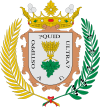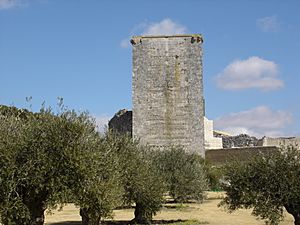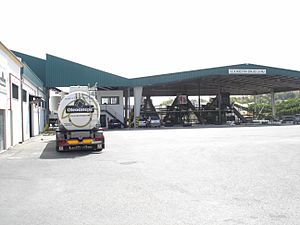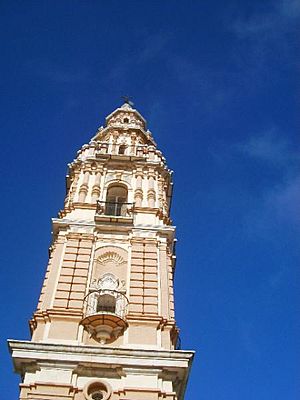Estepa facts for kids
Quick facts for kids
Estepa
|
|||
|---|---|---|---|
|
|||
| Motto(s):
Latin: Ostippo, Quid Ultra?
(Estepa, What else?) |
|||
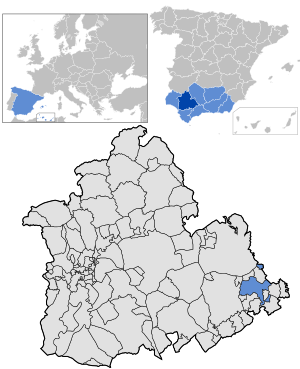 |
|||
| Country | |||
| Autonomous community | |||
| Province | Sevilla | ||
| Comarca | Sierra Sur de Sevilla | ||
| Founded | 1241 | ||
| Area | |||
| • Total | 202.42 km2 (78.15 sq mi) | ||
| Elevation | 604 m (1,982 ft) | ||
| Population
(2018)
|
|||
| • Total | 12,503 | ||
| • Density | 61.768/km2 (159.977/sq mi) | ||
| Demonym(s) | Estepeño/a | ||
| Time zone | UTC+1 (CET) | ||
| • Summer (DST) | UTC+2 (CEST) | ||
| Postal code |
41560
|
||
Estepa is a town in the very south-east part of the province of Seville in Spain. It is a municipality, which is like a local government area. In 2018, about 12,503 people lived there. The town is located north of the Sierra del Becerro mountains.
Contents
History of Estepa
Estepa has a very old history, with many ancient remains still visible today. Some of these remains are from prehistory, which is the time before written records. These include old tools made of flint.
Ancient Times
Later, people from Carthage lived here. We know of at least two early settlements. One was in a place called Los Canterones, about 6 kilometers from where Estepa is now. The other was right under the modern town.
Estepa is mentioned in old writings from classical antiquity (ancient Greek and Roman times). It was known as Astapa and Ostippo. During the Punic Wars, the Romans destroyed the Carthaginian city of Astapa. This event was written about by the Roman historian Titus Livius.
In the Roman period, the town was called Ostippo. It was a free city connected to a larger Roman area called Conventus de Astigi. The Roman city was likely on the highest part of the site, but not much of it remains today. Many signs of farming suggest there were smaller communities in the plains north of Estepa.
Medieval and Modern Eras
People continued to live in Estepa during the Visigothic period, after the Roman Empire. When the Arabs ruled, the town was called Istabba. A famous poet named Al Zawwali lived there for a while.
In 1267, King Fernando III of Spain took the town during the Christian Reconquista (reconquest). He gave Estepa to the Order of Santiago, a group of knights. Their job was to defend the town because it was on the border. Estepa saw its greatest growth in art and buildings during the 16th and 17th centuries. This was when the marquesses of Estepa were in charge. Their palace was built where the old Islamic fortress used to be.
By the 19th century, Estepa was growing, but the old palace was in ruins. The area was also known for bandits. In 1886, Estepa was officially given the title of "city" (ciudad). During the Spanish Civil War, forces loyal to Francisco Franco quickly took control of the town. After the war, many people were poor. This led to many leaving Estepa in the 1950s and 1960s. They moved to industrial areas in Spain and other European countries to find work. This is why the population stayed about the same for a long time.
Economy of Estepa
Estepa is famous for making Christmas sweets, especially mantecados. These are traditional Spanish crumble cakes made with pork fat. Since 2009, these sweets have a special protection called a "protected designation of origin." This means they can only be called Mantecados de Estepa if they are made in Estepa following certain rules.
Estepa has 30 factories that make these sweets. About 15 of them work together to export their products. These factories make around 18 million kilograms of Christmas sweets each year. From September to December, they hire about 2,000 people. More than 90% of these workers are women.
Other Industries
Other types of businesses are also growing in Estepa. These include graphic arts, making machines, transport, and producing limestone. South of the mountains, there is a large industrial area called "The Heart of Andalucia." It has over 140,000 square meters of space for businesses.
Agriculture and Tourism
Growing olives is a very important farming activity. About 9,500 hectares of land in the area are covered with olive trees. Around 24 million kilograms of olive oil are produced each year. This olive oil also has a "protected designation of origin," ensuring its quality and origin.
Tourism is also a big part of Estepa's economy. Visitors can explore many historical places and buildings. These include:
- The Convento de Santa Clara (a convent)
- The Convento de San Francisco (another convent)
- The ruined fortress (Antiguo Alcázar)
- The Torre de la Victoria (a church tower)
- The Balcón de Andalucia (a viewpoint with great views)
- Many beautiful churches
Twin Towns
Estepa has special friendships with other towns around the world. These are called "twin towns":
 Badia Polesine, Italy
Badia Polesine, Italy Bédarieux, France
Bédarieux, France Corrientes, Argentina
Corrientes, Argentina Piera, Spain
Piera, Spain
See also
 In Spanish: Estepa (Sevilla) para niños
In Spanish: Estepa (Sevilla) para niños



